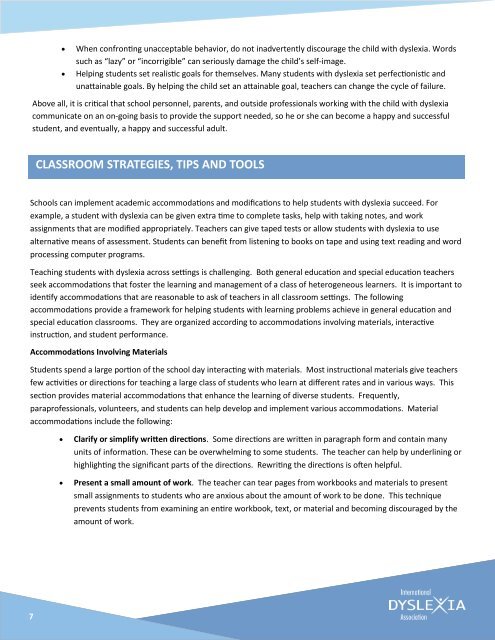Overcoming Dyslexia
Overcoming Dyslexia
Overcoming Dyslexia
Create successful ePaper yourself
Turn your PDF publications into a flip-book with our unique Google optimized e-Paper software.
When confronting unacceptable behavior, do not inadvertently discourage the child with dyslexia. Words<br />
such as “lazy” or “incorrigible” can seriously damage the child’s self-image.<br />
Helping students set realistic goals for themselves. Many students with dyslexia set perfectionistic and<br />
unattainable goals. By helping the child set an attainable goal, teachers can change the cycle of failure.<br />
Above all, it is critical that school personnel, parents, and outside professionals working with the child with dyslexia<br />
communicate on an on-going basis to provide the support needed, so he or she can become a happy and successful<br />
student, and eventually, a happy and successful adult.<br />
CLASSROOM STRATEGIES, TIPS AND TOOLS<br />
Schools can implement academic accommodations and modifications to help students with dyslexia succeed. For<br />
example, a student with dyslexia can be given extra time to complete tasks, help with taking notes, and work<br />
assignments that are modified appropriately. Teachers can give taped tests or allow students with dyslexia to use<br />
alternative means of assessment. Students can benefit from listening to books on tape and using text reading and word<br />
processing computer programs.<br />
Teaching students with dyslexia across settings is challenging. Both general education and special education teachers<br />
seek accommodations that foster the learning and management of a class of heterogeneous learners. It is important to<br />
identify accommodations that are reasonable to ask of teachers in all classroom settings. The following<br />
accommodations provide a framework for helping students with learning problems achieve in general education and<br />
special education classrooms. They are organized according to accommodations involving materials, interactive<br />
instruction, and student performance.<br />
Accommodations Involving Materials<br />
Students spend a large portion of the school day interacting with materials. Most instructional materials give teachers<br />
few activities or directions for teaching a large class of students who learn at different rates and in various ways. This<br />
section provides material accommodations that enhance the learning of diverse students. Frequently,<br />
paraprofessionals, volunteers, and students can help develop and implement various accommodations. Material<br />
accommodations include the following:<br />
<br />
<br />
Clarify or simplify written directions. Some directions are written in paragraph form and contain many<br />
units of information. These can be overwhelming to some students. The teacher can help by underlining or<br />
highlighting the significant parts of the directions. Rewriting the directions is often helpful.<br />
Present a small amount of work. The teacher can tear pages from workbooks and materials to present<br />
small assignments to students who are anxious about the amount of work to be done. This technique<br />
prevents students from examining an entire workbook, text, or material and becoming discouraged by the<br />
amount of work.<br />
7

















